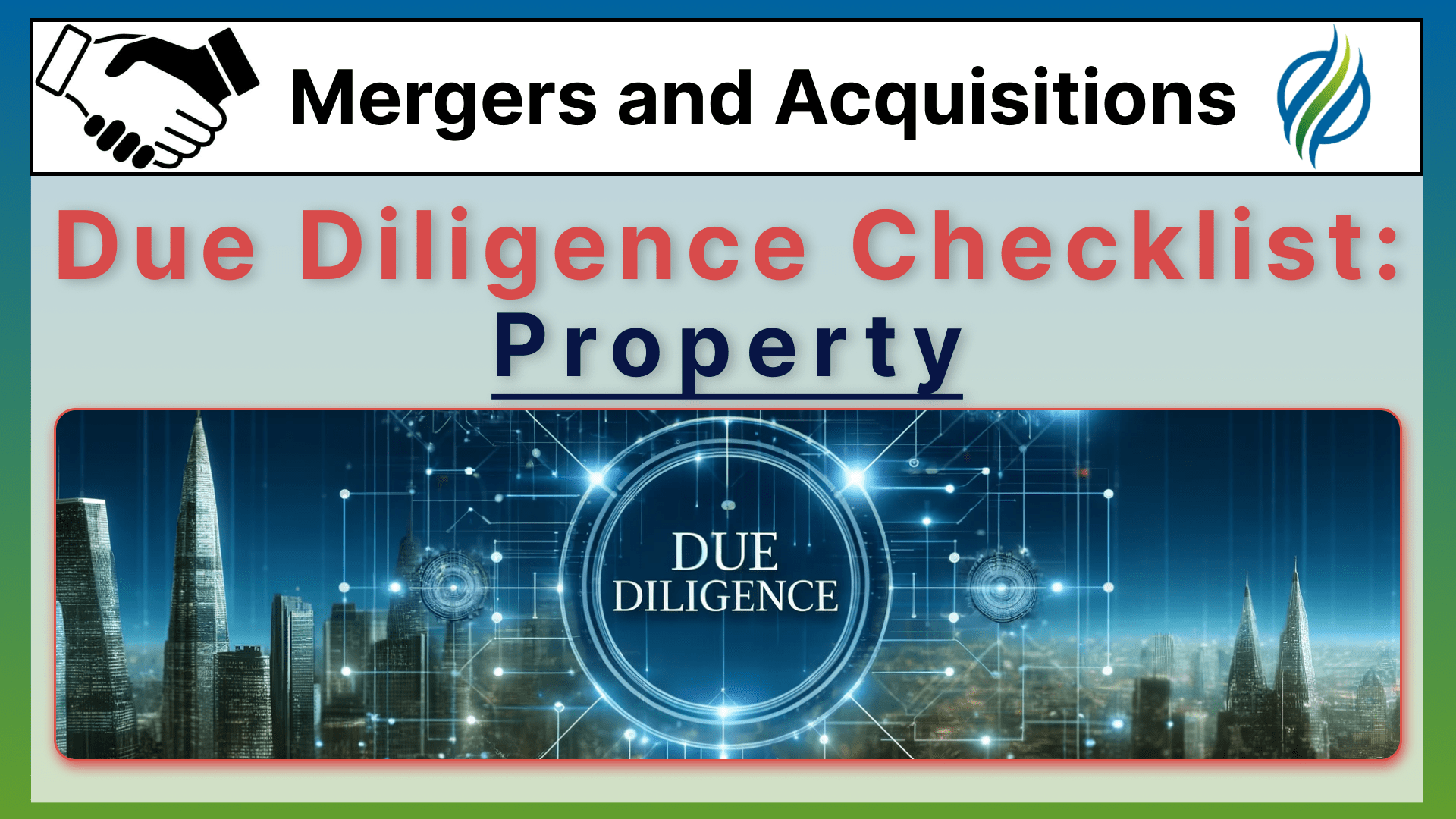In mergers and acquisitions, thorough property due diligence is crucial.
This article dives deep into the steps and benefits of reviewing property assets.
It explains why understanding property ownership, leases, and asset conditions is essential for a smooth acquisition.
You’ll learn practical steps to evaluate deeds, titles, leases, and equipment.
 Key Takeaways
Key Takeaways
- Verify property ownership and check for liens to avoid future disputes.
- Review lease terms to understand financial commitments and potential liabilities.
- Inspect equipment condition to assess usability and necessary repairs.
- Analyze financing leases and sale agreements for financial impact and risks.
- Evaluate conditional sale agreements and operating leases for long-term obligations and liabilities.
By following this guide, you can avoid costly mistakes and make informed decisions.
Read on to ensure you cover all bases in your property due diligence process and confidently move forward with your acquisition.
Ready to dive in?
Let’s get started!
 Table of Contents
Table of Contents
A thorough review of all property owned or used by the target company is a fundamental aspect of any due diligence process.
This encompasses real estate, equipment, and other tangible assets critical to the business.
Ensuring accurate property records and understanding any liabilities associated with these assets can significantly impact the valuation and feasibility of the acquisition.

➤ MORE: Check out the FULL Due Diligence Checklist here
Review Deeds and Titles:
Obtaining copies of deeds and titles for all owned properties is essential to confirm ownership and identify any encumbrances or liens.
This step ensures that the title to each property is clear and provides a comprehensive understanding of the legal standing and potential liabilities associated with the property.
Practical Benefits:
-
Verifies legal ownership.
-
Identifies potential legal obstacles.
-
Helps avoid future disputes over property rights.
Importance in M&A Due Diligence:
-
Ensures clear ownership and legal standing of properties.
-
Identifies encumbrances that could affect valuation and operational use.
Practical Steps:
-
Request Documentation: Obtain copies of all property deeds and titles from the target company.
-
Verify Ownership: Confirm that the target company is the legal owner of each property listed.
-
Check for Encumbrances: Identify any encumbrances, liens, or restrictions on the property.
-
Consult Legal Experts: Have legal counsel review the documents to ensure accuracy and compliance with local laws.
Self-Assessment Questions:
-
Are all property deeds and titles up to date and accurate?
-
Are there any encumbrances or liens on the properties?
-
How critical are these properties to the company’s operations?
-
What is the current market value of these properties?
Examine Real Estate Leases:
Reviewing real estate leases and purchase agreements is crucial to understand the company’s real estate commitments and potential liabilities.
Analyzing the terms related to rent, renewal options, and maintenance responsibilities helps assess the impact of these agreements on the company’s financial health and operational flexibility.
Practical Benefits:
-
Provides clarity on real estate obligations.
-
Identifies potential long-term financial commitments.
-
Assesses impact on operational flexibility.
Importance in M&A Due Diligence:
-
Ensures awareness of all leasing commitments.
-
Identifies potential liabilities and obligations.
-
Helps evaluate the financial stability and sustainability of the business.
Practical Steps:
-
Collect Lease Agreements: Obtain copies of all current real estate leases and purchase agreements.
-
Review Lease Terms: Analyze key terms such as rent, renewal options, and maintenance responsibilities.
-
Assess Financial Impact: Evaluate how these lease terms affect the company’s cash flow and financial obligations.
-
Compare Market Rates: Compare lease terms to current market rates to assess competitiveness.
Self-Assessment Questions:
-
What are the key terms and conditions of the real estate leases and purchase agreements?
-
How long are the lease terms, and are there renewal options?
-
What are the maintenance and repair responsibilities?
-
Are there any restrictions or obligations that could impact the company’s operations?
-
How competitive are the lease terms compared to market rates?
Assess Equipment and Asset Condition:
Inspecting the condition of equipment and other assets through site visits is vital to evaluate their usability and lifespan.
This assessment helps determine the current state of the company’s tangible assets, identify any significant repair or replacement needs, and understand the maintenance practices in place.
Practical Benefits:
-
Evaluates the operational readiness of equipment.
-
Identifies potential capital expenditures.
-
Assesses maintenance practices and asset management.
Importance in M&A Due Diligence:
-
Determines the current value and future usability of assets.
-
Identifies any immediate repair or replacement needs.
-
Provides insight into the company’s asset management practices.
Practical Steps:
-
Schedule Site Visits: Arrange visits to all locations where the company’s equipment and assets are housed.
-
Inspect Equipment: Conduct thorough inspections to assess the condition and functionality of key assets.
-
Identify Repairs: Document any significant repairs or replacements needed.
-
Review Maintenance Records: Examine the company’s maintenance records to evaluate asset management practices.
Self-Assessment Questions:
-
What is the current condition of the company’s equipment and assets?
-
Are there any significant repairs or replacements needed?
-
How does the company maintain its equipment and assets?
-
What is the estimated remaining lifespan of key assets?
Review Financing Leases and Sale and Leaseback Agreements:
Analyzing financing leases and sale and leaseback agreements helps assess the company’s financial obligations and the impact on cash flow.
Understanding these financial arrangements is critical to evaluating the sustainability and risks associated with the company’s financial strategy.
Practical Benefits:
-
Clarifies financial commitments and obligations.
-
Evaluates impact on cash flow.
-
Identifies potential risks associated with financial agreements.
Importance in M&A Due Diligence:
-
Provides a clear picture of financial liabilities.
-
Assesses the impact of financing arrangements on the company’s financial health.
-
Identifies risks and benefits of existing financial agreements.
Practical Steps:
-
Collect Agreements: Obtain copies of all financing leases and sale and leaseback agreements.
-
Review Terms and Conditions: Analyze the key terms and conditions of each agreement.
-
Evaluate Cash Flow Impact: Assess how these agreements affect the company’s cash flow and financial stability.
-
Identify Risks: Identify any risks associated with these financial arrangements and consider mitigation strategies.
Self-Assessment Questions:
-
What financing leases and sale and leaseback agreements are in place?
-
What are the key terms and conditions of these agreements?
-
How do these agreements impact the company’s cash flow?
-
Are there any risks associated with these financial arrangements?
Evaluate Conditional Sale and Operating Leases:
Reviewing conditional sale agreements and operating leases is essential to understand the company’s commitments and potential liabilities related to leased assets.
This evaluation provides insights into the long-term financial and operational implications of these agreements.
Practical Benefits:
-
Clarifies long-term commitments and liabilities.
-
Assesses the financial impact of leased assets.
-
Identifies potential risks and benefits of lease agreements.
Importance in M&A Due Diligence:
-
Ensures awareness of all leasing commitments and obligations.
-
Helps evaluate the sustainability of financial arrangements.
-
Identifies risks associated with conditional sales and operating leases.
Practical Steps:
-
Gather Agreements: Collect copies of all conditional sale agreements and operating leases.
-
Review Key Terms: Analyze the key terms and conditions, including payment schedules and obligations.
-
Assess Impact: Evaluate the financial and operational impact of these agreements on the company.
-
Identify Liabilities: Identify any liabilities and risks associated with these leases and consider mitigation strategies.
Self-Assessment Questions:
-
What conditional sale agreements and operating leases are in place?
-
What are the key terms and conditions of these agreements?
-
How critical are these leased assets to the company’s operations?
-
Are there any risks or liabilities associated with these leases?
FAQs - Frequently Asked Questions About Property Due Diligence in the M&A Process

What is property due diligence in M&A?
It's the review of all property-related assets and liabilities of the target company.
Learn More...
Property due diligence involves a thorough review of real estate, equipment, and other tangible assets owned or used by the target company.
This includes verifying ownership through deeds and titles, examining real estate leases, assessing equipment condition, and analyzing financial leases and sale agreements.
Ensuring all property aspects are understood helps identify potential risks and provides a clear asset value.
Why is verifying property ownership important in M&A?
It confirms legal ownership and uncovers potential legal obstacles.
Learn More...
Verifying property ownership through deeds and titles is crucial as it confirms the target company’s legal right to the property.
This step helps uncover any encumbrances, liens, or legal issues that could affect the property's value or transferability.
Ensuring clear ownership prevents future legal disputes and provides assurance to the acquiring company.
What are the key elements to review in real estate leases during M&A?
Review rent terms, renewal options, and maintenance responsibilities.
Learn More...
Key elements to review in real estate leases include the rent amount, duration of the lease, renewal options, and maintenance and repair responsibilities.
Understanding these terms helps assess the financial impact and operational implications of the leases.
Comparing lease terms to market rates can provide insights into competitiveness and financial viability.
How do you assess the condition of a company's equipment during due diligence?
Conduct site visits to inspect equipment and review maintenance records.
Learn More...
Assessing the condition of a company's equipment involves conducting site visits to inspect the physical state and functionality of the assets.
Reviewing maintenance records helps understand how well the equipment has been maintained and identifies any significant repairs or replacements needed.
Evaluating the remaining lifespan of key assets provides a clearer picture of future capital expenditure requirements.
What are financing leases and sale and leaseback agreements?
Financing leases are long-term leases used for financing purposes.
Sale and leaseback agreements involve selling an asset and leasing it back.
Learn More...
Financing leases are long-term leases where the lessee can use the asset but the lessor retains ownership.
These leases help finance high-value assets without significant upfront costs.
Sale and leaseback agreements allow a company to sell an asset to a lessor and then lease it back, providing immediate capital while retaining the use of the asset.
These arrangements can improve cash flow and financial flexibility, essential for strategic financial planning.
Why is it important to review conditional sale and operating leases?
It helps understand financial obligations and risks, clarifying long-term commitments.
Learn More...
Conditional sale agreements involve the sale of an asset under specific conditions, usually requiring the buyer to fulfill certain obligations before obtaining full ownership.
Operating leases are short-term leases that allow the lessee to use the asset without ownership.
Understanding these terms is crucial for assessing financial and operational commitments.
Reviewing these agreements ensures all conditions and obligations are clear, aiding in accurate financial planning and risk management.
How can a thorough property due diligence process benefit an M&A deal?
It ensures accurate valuation and identifies potential risks, providing a clear understanding of assets and liabilities.
Learn More...
A thorough property due diligence process helps accurately value the target company's assets by confirming ownership, assessing property and equipment condition, and understanding financial commitments.
This process identifies potential risks such as encumbrances or repair needs, allowing the acquiring company to make informed decisions and negotiate better terms.
Understanding all property aspects ensures a smoother acquisition process, reducing surprises and enhancing strategic planning.
What resources are available to assist with property due diligence in M&A?
Use title reports, property appraisals, and legal reviews, and consult experts.
Learn More...
Resources to assist with property due diligence include title reports from title companies, property records from the County Assessor’s Office, and real estate appraisals from professional appraisers.
Legal reviews of deeds, leases, and financial agreements by qualified attorneys are also crucial.
These resources ensure that all property-related aspects are thoroughly examined, providing a comprehensive understanding of the target company's assets and liabilities.
In Summary…
Conducting comprehensive property due diligence is a vital component of any successful merger or acquisition.
This article provided an in-depth look at the essential steps to ensure all property-related aspects are thoroughly reviewed and understood.
By following the guidelines for verifying deeds and titles, examining real estate leases, assessing equipment condition, and analyzing financial and operating leases, entrepreneurs can make informed decisions, mitigate risks, and avoid costly surprises.
Applying this information practically means you’ll have a clear picture of the target company’s assets and liabilities, enabling smoother negotiations and a more secure acquisition process.
You’ll gain insights into the true value and potential issues of the properties, ensuring that your investment is sound and strategic.
To leverage these insights for your next M&A transaction, schedule a consultation call with us or use our contact form to get personalized advice and support.
Stay informed with our Initiative Newsletter and explore more valuable resources by following Business Initiative on X.
Ready to take the next step in your M&A journey?
Contact us today and let’s ensure your success together!
Sources
- Fortune Builders - What is a Title Report
- Real Estate Law Corp - Due Diligence in Real Estate Transactions
- Zillow - Title Insurance
- Contract Counsel - Commercial Real Estate Review Guide
- Bankrate - Morgage Rate Comparison
- Contract Counsel - Legal Review of Lease Agreements
- Go Codes - Equipment Inspection Guide
- Argo Software - Asset Management
- Preventive Support - Building Maintenance Checklist
- iLease Pro - Lease Analysis Guide
- Fool - Sale and Leaseback Agreement Overview
- Allianz - Financial Risk Assessment
- Cornell - Conditional Sales Guide
- Smartsheet - Business Impact Assessment


